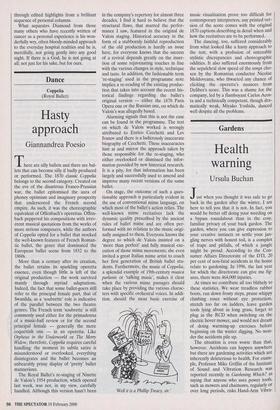Dance
Coppelia (Royal Ballet)
Hasty approach
Giannandrea Poesio
There are silly ballets and there are bal- lets that can become silly if badly produced or performed. The 1870 classic Coppelia belongs to the second category. Created on the eve of the disastrous Franco-Prussian war, the ballet epitomised the aura of phoney optimism and imaginary prosperity that underscored the French second empire. As such, it was the choreographic equivalent of Offenbach's operettas. Offen- bach peppered his compositions with irrev- erent musical quotations from the works of more serious composers, while the authors of Coppelia opted for a ballet that mocked the well-known features of French Roman- tic ballet, the genre that dominated the European ballet scene from 1832 to the 1860s.
More than a century after its creation, the ballet retains its sparkling operetta essence, even though little is left of the original production — the work survived mainly through myriad adaptations. Indeed, the fact that some ballet-goers still refer to the principal female part, that of Swanilda, as a 'soubrette' role is indicative of the parallel between the two theatre genres. The French term 'soubrette' is still commonly used either for the primadonna of a music-hall review or for the second principal female — generally the more coquettish one — in an operetta. Like Orpheus in the Underworld or The Merry Widow, therefore, Coppelia requires careful handling: the moment its subtle satire is misunderstood or overlooked, everything disintegrates and the ballet becomes an unbearably prissy display of 'pretty' ballet mannerisms.
The Royal Ballet's re-staging of Ninette de Valois's 1954 production, which opened last week, was not, in my view, carefully handled. Although this version hasn't been in the company's repertory for almost three decades, I find it hard to believe that the structural flaws, that marred the perfor- mance I saw, featured in the original de Valois staging. Historical accuracy in the form of a stubbornly faithful reproduction of the old production is hardly an issue here, for everyone knows that the success of a revival depends greatly on the inser- tion of some rejuvenating touches in line with the various changes in style, technique and taste. In addition, the fashionable term `re-staging' used in the programme note implies a re-reading of the existing produc- tion that takes into account the recent his- torical findings regarding the ballet's original version — either the 1870 Paris Opera one or the Russian one, on which de Valois's was allegedly based.
Alarming signals that this is not the case can be found in the programme. The text on which de Valois worked is wrongly attributed to Enrico Cecchetti and Lev Ivanov and there is a ludicrously inaccurate biography of Cecchetti. These inaccuracies hint at and mirror the approach taken by those responsible for the re-staging, who either overlooked or dismissed the infor- mation provided by new historical research. It is a pity, for that information has been largely and successfully used to amend and improve many recent versions of the same ballet.
On stage, the outcome of such a ques- tionable approach is particularly evident in the use of conventional mime language, on which most of the ballet's action relies. The well-known mime recitatives lack the dynamic quality prescribed by the ancient rules of ballet mime and are often per- formed with no relation to the music origi- nally assigned to them. Everyone knows the degree to which de Valois insisted on a `more than perfect' and fully musical exe- cution of those mime movements; she even invited a great Italian mime artist to coach her first generation of British ballet stu- dents. Furthermore, the music of Coppelia, a splendid example of 19th-century musica parlante or 'talking music', makes it clear when the various mime passages should take place by providing the various charac- ters with specific orchestral voices. In addi- tion, should the most basic exercise of `Well it is a Phillip Treacy, sir.' music visualisation prove too difficult for contemporary interpreters, any printed ver- sion of the score comes with the original 1870 captions describing in detail when and how the recitatives are to be performed.
The dancing, too, suffered considerably from what looked like a hasty approach to the text, with a profusion of untenable stylistic discrepancies and choreographic oddities. It also suffered enormously from the sepulchral slow speed of the tempi cho- sen by the Romanian conductor Nicolae Moldoveanu, who thwarted any chance of eliciting the operetta's nuances from Delibes's score. This was a shame for the company, led by a flamboyant Carlos Acos- ta and a technically competent, though dra- matically weak, Miyako Yoshida, danced well despite all the problems.


































































 Previous page
Previous page